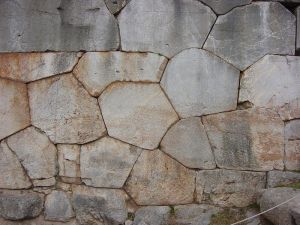Entropy, patina, the built environment
8 August 2008 3 Comments
I’ve cited Alain de Botton‘s book The Architecture of Happiness a few times on The Aesthetic Elevator now after hearing him talk on NPR a couple years ago, particularly with respect to personal aesthetics. Last month I purchased the book as part of our anniversary celebration, and began reading it this week. Botton isn’t an architect — he’s a writer — but his observations on aesthetics and how the built environment plays into our everyday lives appear sound from the little I know so far.
Last night I read a paragraph from the book that said this:
When we have attained our [architectural] goals, our buildings have a grievous tendency to fall apart again with precipitate speed. It can be hard to walk into a freshly decorated house without feeling pre-emptively sad at the decay impatiently waiting to begin: how soon the walls will crack, the white cupboards will yellow and the carpets stain. The ruins of the Ancient World offer a mocking lesson for anyone waiting for builders to finish their work. How proud the householders of Pompeii must have been.
The idea of entropy, things falling apart, makes tangential appearances in my artwork and philosophy from time to time. This is especially true when I’m thinking about and employing found objects. It’s an interesting point Botton makes in the quote, but I’d like to counter it with something he didn’t mention (maybe it’s brought up later in the book, but I wouldn’t know about that yet).
Yes, all things tend towards disorder, disintegration. I have a sense, even, that American environments (Botton is a Swiss born Brit) tend to appear more disintegrated than some others. We’re a youthful country of efficiency, efficiency on the front end. We want it and we want it now, and who cares what happens over time with whatever it is. In other words, it’s more important to have the house now than to wait five years and save enough money so that it can be built well. It’s more important to stand in line for half a day to purchase an iPhone than wait for a later model where the bugs will be worked out. You get catch my drift.
Our built environment often reflects our myopic culture. We build cheaply with cheap materials in a lot of cases, figuring we’ll just demolish and rebuild on the same plot when we need to. It’s good for the economy, right? The builders have work, the demolition crews get paid and the garbage men have truckloads of debris to carry to the landfills.
What if we were to take a little more time and spend a little more money building our cities, using more enduring materials. Yes, entropy will still take hold, but there are ways we can guide it to our aesthetic advantage. Stone, concrete and clay (brick) will last a long time if properly put together and cared for. Sure, they might take more energy to produce in the short-term, but they’ll also be around a lot longer than most stick framed houses which makes them a sustainable choice as well as an aesthetic one.
The above photograph demonstrates the kind of patina age can give to certain materials, a beautiful patina that modern homeowners try and replicate. The color of durable woods — by durable I mean harder woods that stand up to rot and termites better than pine or fir — is also very agreeable with age. I plan to create a dining room table out of old hard oak salvaged from a remodel job I worked on three years ago. Some of the rough cut boards are quarter sawn and others plain sawn, they vary in color and are full of little nail holes, but the finished product will be gorgeous if I can pull it off.
My point is that age, decay, in certain materials doesn’t have to be an exclusively sad event, and in fact can be cause for rejoicing. The concrete block patio in my backyard is far more interesting now that it has a few more years under its belt. The stains and moss give the surface a visual depth that new concrete just doesn’t have. Further, it’s just as strong as when it was new; recalling my strengths of materials course in college, concrete actually hardens as it ages.
Photo from Wikipedia

i love how good materials age. gives them character. my preference is probably unusual though – i like hundred year old buildings over new ones, and if it’s going to be new, it should be capable of lasting a hundred years. don’t know why, it’s just what i like.
I’d also much prefer to be in a well-crafted older building (although this may be largely on account of the poorer design/fabrication of homes and buildings over the last 50 years+). I’ve found, though, that my allergies to mold aren’t always conducive to that. Of course, neither is living in Arkansas, with all of its flora and rainfall.
Pingback: The real and the imitation « The Aesthetic Elevator